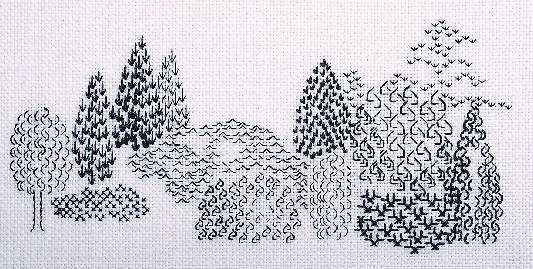Use simple
repeating patterns worked in different weights of thread to capture the
forms and textures found in a group of trees
photos
by Ian Cole
The fascination of blackwork lies in the enormous number of patterns possible; the patterns chosen for use here are individual units. These can be widely or closely spaced, parts of the pattern can be left out, or extra stitches may be added. These variations, together with the use of different weights of thread, help to give a natural shading effect. Traditionally, blackwork is worked in double running stitch, also known as Holbein stitch, but it is easier to create these individual patterns in back stitch.
What you need
- 25 x 18 cm Hardanger fabric
- (22 threads to the inch)
- Machine sewing thread, cotton or polyester, in black
- Stranded cotton, one skein of black (1 strand only is used)
- Cotton perle no.12 in black
- Cotton perle no. 8 in black
- Fine tapestry needles, sizes 24 and 26
- Rectangular embroidery frame
What you do
On Hardanger fabric threads are arranged in pairs. Treat each pair of threads as a single thread; one back stitch is therefore worked over one pair of threads.
- Mount the Hardanger fabric in your embroidery frame (see Back to Basics).
- Throughout the embroidery use back stitch where possible. All stitches are worked over one or two blocks or pairs of threads of the fabric. See the chart for which thread to use.
- Start each pattern in the centre of a tree or bush shape. Complete each tree before moving on to the next one.

- If you wish, the design can be stitched from this close-up photograph of the finished piece.
Stitching Guide
The blackest areas - Cotton perle no.8
Next blackest - Cotton perle no. 12
Finer stitching - 1 strand of stranded cotton
Finest stitching - machine sewing thread
Colour fades as it recedes into the distance. Use a lighter weight of thread to create perspective.
Create your own picture
The ideas explored here could be used to create a design based on a picture of your own. If you don't have a photograph of trees to work from, postcards, gardening magazines and calendars are all good places to find inspiration.
- Trace your picture onto tissue paper or greaseproof paper.
- Pin the tracing to your fabric and work running stitch around the outlines of the trees, stitching through the fabric and the tracing paper.
- When all of the outlines have been transferred, use the point of a needle to score the paper near to the stitching and then carefully tear away the paper, leaving the stitched outlines on the fabric.
- Fill in the outlines with patterns of your choice. Remember to vary the thickness of the thread and the density of pattern using some dark, some light, some small and some large patterns.
- When stitching is complete, remove the running-stitch outlines.
(Above and below) The repeating pattern you use should reflect the characteristics of the tree it depicts.
Suggestions
Individual trees would make ideal projects for greetings cards.
Blackwork does not have to be stitched with black threads. Choose another colour of thread, or even try stitching in white on a dark fabric.
The repeating pattern you use should reflect the characteristics of the tree it is used for. The spiky 'arrow' works well for the fir tree (top picture, centre), the broader pattern echoes the spreading tree (bottom picture, 2nd from right), and the elongated pattern reflects the shape of the drooping willow tree (bottom picture, last on right).
These designs can also be worked on a blockweave fabric, such as 14 count aida (one back stitch is worked over one block), or on a single-thread evenweave fabric with 27 or 28 threads to the inch (one back stitch is worked over two threads of fabric). This will increase the size of the finished piece and you will need a piece of fabric approximately 50 x 36 cm.
If you would like to take these ideas further, lookout for Blackwork by Lesley Barnett, published by Search Press, price £5.95. It is available from the Embroiderers' Guild Bookshop

